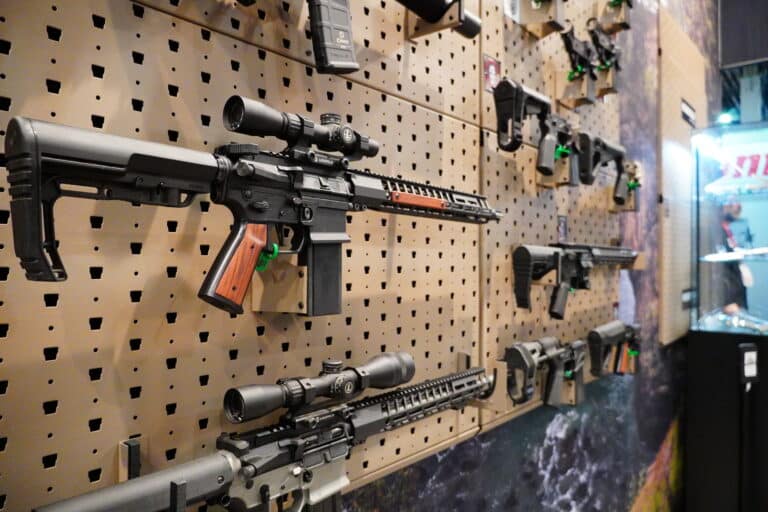The Land of Lincoln can’t ban AR-15s and other popular firearms.
That’s the ruling a federal judge handed down on Friday. Judge Stephen P. McGlynn of the Southern District of Illinois once again found the Protect Illinois Communities Act (PICA) unlawful because it bans common firearms and accessories, and the state “may not deprive law-abiding citizens of their guaranteed right to self-defense as a means of offense.” He issued a permanent injunction against the law after calling it “an unconstitutional affront to the Second Amendment” that “must be enjoined” about a year and a half after first blocking its enforcement in a preliminary hearing.
“[T]he Court holds that the provisions of PICA criminalizing the knowing possession of specific semiautomatic rifles, shotguns, magazines, and attachments are unconstitutional under the Second Amendment to the United States Constitution as applied to the states by the Fourteenth Amendment,” Judge McGlynn wrote in Barnett v. Raoul. “Therefore, the Plaintiffs’ request for a permanent injunction is GRANTED.”
He also found the state’s registration requirement for those guns ran afoul of federal gun-rights protections.
“As the prohibition of firearms is unconstitutional, so is the registration scheme for assault weapons, attachments, and large-capacity magazines,” McGlynn, a Donald Trump appointee, wrote. “Therefore, the State of Illinois is ENJOINED from enforcing the firearm registration requirements and penalties associated with entering false information on the endorsement affidavit for non-exempt weapons, magazines, and attachments previously required to be registered[.]”
The ruling is a win for gun-rights activists who’ve suffered numerous setbacks in their fight against PICA since McGlynn’s first ruling. A panel on the Seventh Circuit Court of Appeals vacated that ruling and found Illinois’s ban was likely constitutional. The Supreme Court declined to take up the case at that point and sent it back down to McGlynn for a ruling on the merits. With his new ruling siding with them on the merits, gun-rights activists can start climbing their way back up that later to the High Court once again.
Last November, the panel handed down a 2-1 decision finding semiautomatic AR-15s and the magazines that come standard with them are not “arms” under the Second Amendment because they are “indistinguishable” from their fully-automatic counterparts.
“Based on the record before us, we are not persuaded that the AR-15 is materially different from the M16,” Judge Diane Wood, a Bill Clinton appointee, wrote in Bevis v. Naperville. “Heller informs us that the latter weapon is not protected by the Second Amendment, and therefore may be regulated or banned. Because it is indistinguishable from that machinegun, the AR-15 may be treated in the same manner without offending the Second Amendment.”
Judge Wood cited the Supreme Court’s holding in DC v. Heller that certain guns fell outside the scope of the Second Amendment, including “weapons that are most useful in military service—M-16 rifles and the like.” She said AR-15s, the semiautomatic cousins of M-16s, were similar enough to be banned as well.
“We come to this conclusion because these assault weapons and high-capacity magazines are much more like machineguns and military grade weaponry than they are like the many different types of firearms that are used for individual self-defense (or so the legislature was entitled to conclude),” Wood wrote. “Indeed, the AR-15 is almost the same gun as the M16 machinegun. The only meaningful distinction, as we already have noted, is that the AR-15 has only semiautomatic capability (unless the user takes advantage of some simple modifications that essentially make it fully automatic), while the M16 operates both ways.”
In a statement attached to the Supreme Court’s notice that it had declined to take up the case, Justice Clarance Thomas attacked the panel’s decision and urged the Court to take up the case if it came back to them after a final judgment.
“This Court is rightly wary of taking cases in an interlocutory posture. But, I hope we will consider the important issues presented by these petitions after the cases reach final judgment,” he wrote. “We have never squarely addressed what types of weapons are ‘Arms’ protected by the Second Amendment.”
He called the Seventh Circuit’s decision to exclude AR-15s from the list of protected arms “contrived” and “unmoored from both text and history.” He argued, “Even on its own terms, the Seventh Circuit’s application of its definition is nonsensical.”
“It is difficult to see how the Seventh Circuit could have concluded that the most widely owned semiautomatic rifles are not ‘Arms’ protected by the Second Amendment,” Justice Thomas wrote. “[I]f the Seventh Circuit ultimately allows Illinois to ban America’s most common civilian rifle, we can—and should—review that decision once the cases reach a final judgment. The Court must not permit ‘the Seventh Circuit [to] relegat[e] the Second Amendment to a second-class right.’
Judge McGlynn ultimately tried to reconcile the Supreme Court and Seventh Circuit’s rulings on the matter.
“The AR-15 is the Rorschach test of America’s gun debate. In listening to the political debate and in reading various judicial interpretations of what the AR-15 represents, it is obvious that many are seeing very different creatures,” he wrote. “Many see one, but not the other. Our task here is to understand the duality of much of the data and the reasons for varying interpretations. Are they seeing a dragon to be slayed or a horse to pull a carriage? Often, the different perspectives are defined by whom they picture using the weapon—either a menacing criminal or a law-abiding citizen involved in a dangerous confrontation.”
He found that most of the weapons banned by PICA are protected, even under the Seventh Circuit panel’s reasoning.
“[T]he Court holds that the Plaintiffs have met their burden to demonstrate that the AR-15 and other AR-style weapons are protected ‘Arms’ within the definition advanced by the Seventh Circuit in Friedman and Bevis,” Judge McGlynn wrote. “Additionally, the Court holds that the various other ‘assault weapons’ proscribed by PICA (including AK-type weapons, various semiautomatic shotguns, and what the Government calls ‘submachineguns’) are also ‘Arms,’ as are the thirty-round large-capacity magazines and various firearm attachments designated by PICA. To reiterate, all of these weapons, magazines, and attachments are bearable, not dangerous or unusual, and are in common use. Moreover, they are all possessed for lawful self-defense purposes, are either not predominately useful for military service or are dual-use items, and are not possessed for unlawful purposes.”
He further found there was no historical tradition that would allow the government to undermine those protections and ban popular firearms.
“Sadly, there are those who seek to usher in a sort of post-Constitution era where the citizens’ individual rights are only as important as they are convenient to a ruling class,” he wrote. “Seeking ancient laws that may partner well with a present-day infringement on a right proclaimed in the Bill of Rights without reading it in conjunction with the aforementioned history is nonsense. The Statute of Northampton cannot in the least bit be used to vex the rights of Illinois citizens in the 21st century to keep and bear arms. The oft-quoted phrase that ‘no right is absolute’ does not mean that fundamental rights precariously subsist subject to the whims, caprice, or appetite of government officials or judges.”
However, he ruled .50 caliber rifles, belt-fed weapons, and grenade launchers are not protected under the same standards. Ultimate, Judge McGlynn concluded Americans should have access to whatever commonly used weapons they believed would give them the best chance of surviving a hostile encounter with somebody who meant them harm.
“When facing the possibility of armed confrontation either within one’s home or outside of it, specific weapons may confer advantages that would enable a law-abiding citizen to successfully defend oneself and one’s family from armed confrontation,” he wrote. “To limit civilians’ choice of arms would tip the scale in favor of the aggressors, who already will likely have various tactical advantages, including the element of surprise.”
Judge McGlynn issued a 30-day stay on his order, which is common in federal court rulings. That will allow Illinois to appeal his ruling back up to the Seventh Circuit if it chooses to do so.






